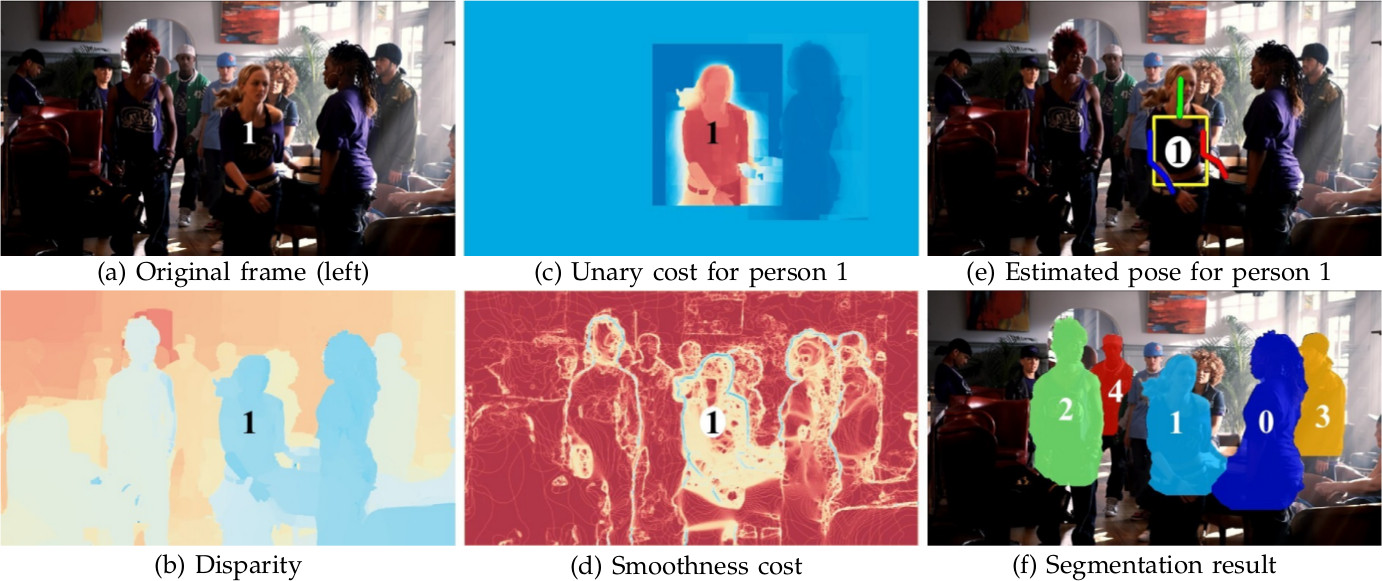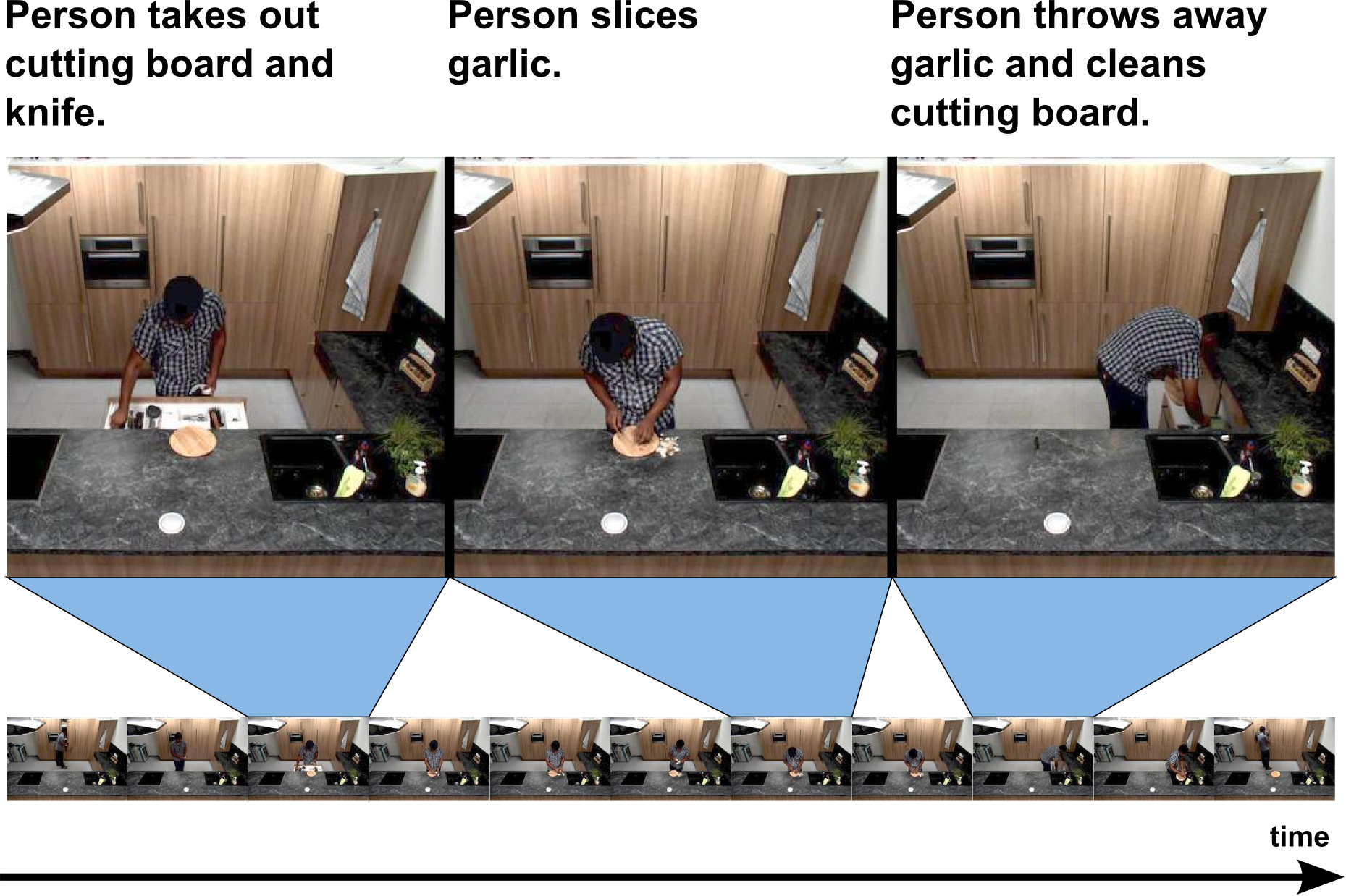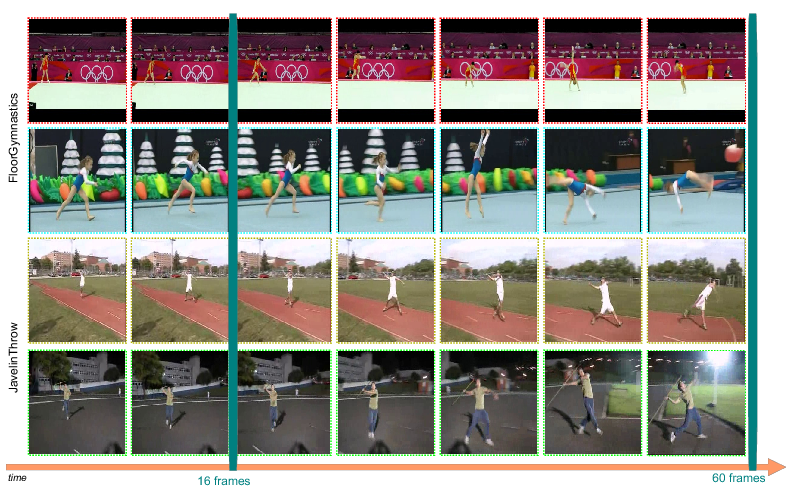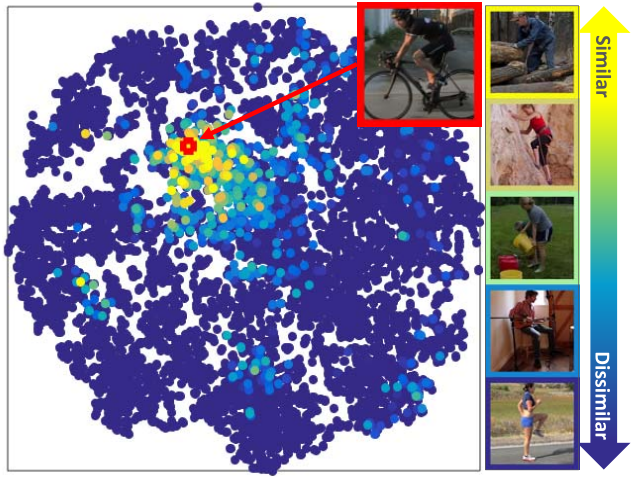Section: New Results
Human activity capture and classification
P-CNN: Pose-based CNN Features for Action Recognition
Participants : Guilhem Chéron, Ivan Laptev, Cordelia Schmid.
This work [9] targets human action recognition in video. We argue for the importance of a representation derived from human pose. To this end we propose a new Pose-based Convolutional Neural Network descriptor (P-CNN) for action recognition. The descriptor aggregates motion and appearance information along tracks of human body parts as shown in Figure 10 . We experiment with P-CNN features obtained both for automatically estimated and manually annotated human poses. We evaluate our method on JHMDB and MPII Cooking datasets. For both datasets our method shows consistent improvement over the state of the art. This work has been published at ICCV 2015 [9] , and P-CNN code (Matlab) is available online at http://www.di.ens.fr/willow/research/p-cnn/ .
|
Context-aware CNNs for person head detection
Participants : Tuan-Hung Vu, Anton Osokin, Ivan Laptev.
Person detection is a key problem for many computer vision tasks. While face detection has reached maturity, detecting people under a full variation of camera view-points, human poses, lighting conditions and occlusions is still a difficult challenge. In this work we focus on detecting human heads in natural scenes. Starting from the recent local R-CNN object detector, we extend it with two types of contextual cues. First, we leverage person-scene relations and propose a Global CNN model trained to predict positions and scales of heads directly from the full image. Second, we explicitly model pairwise relations among objects and train a Pairwise CNN model using a structured-output surrogate loss. The Local, Global and Pairwise models are combined into a joint CNN framework. To train and test our full model, we introduce a large dataset composed of 369,846 human heads annotated in 224,740 movie frames. We evaluate our method and demonstrate improvements of person head detection against several recent baselines in three datasets. We also show improvements of the detection speed provided by our model. This work has been published at ICCV 2015 [18] . The code and the new dataset developed in this work are available online at http://www.di.ens.fr/willow/research/headdetection/ .
On Pairwise Costs for Network Flow Multi-Object Tracking
Participants : Visesh Chari, Simon Lacoste-Julien, Ivan Laptev, Josef Sivic.
Multi-object tracking has been recently approached with the min-cost network flow optimization techniques. Such methods simultaneously resolve multiple object tracks in a video and enable modeling of dependencies among tracks. Min-cost network flow methods also fit well within the “tracking-by-detection” paradigm where object trajectories are obtained by connecting per-frame outputs of an object detector. Object detectors, however, often fail due to occlusions and clutter in the video. To cope with such situations, we propose an approach that regularizes the tracker by adding second order costs to the min-cost network flow framework. While solving such a problem with integer variables is NP-hard, we present a convex relaxation with an efficient rounding heuristic which empirically gives certificates of small suboptimality. Results are shown on real world video sequences and demonstrate that the new constraints help selecting longer and more accurate tracks improving over the baseline tracking-by-detection method. This work has been published at CVPR 2015 [7] .
Pose Estimation and Segmentation of Multiple People in Stereoscopic Movies
Participants : Guillaume Seguin, Karteek Alahari, Josef Sivic, Ivan Laptev.
We describe a method to obtain a pixel-wise segmentation and pose estimation of multiple people in stereoscopic videos, illustrated in Figure 11 . This task involves challenges such as dealing with unconstrained stereoscopic video, non-stationary cameras, and complex indoor and outdoor dynamic scenes with multiple people. We cast the problem as a discrete labelling task involving multiple person labels, devise a suitable cost function, and optimize it efficiently. The contributions of our work are two-fold: First, we develop a segmentation model incorporating person detections and learnt articulated pose segmentation masks, as well as colour, motion, and stereo disparity cues. The model also explicitly represents depth ordering and occlusion. Second, we introduce a stereoscopic dataset with frames extracted from feature-length movies “StreetDance 3D" and “Pina". The dataset contains 587 annotated human poses, 1158 bounding box annotations and 686 pixel-wise segmentations of people. The dataset is composed of indoor and outdoor scenes depicting multiple people with frequent occlusions. We demonstrate results on our new challenging dataset, as well as on the H2view dataset from (Sheasby et al.'s ACCV 2012). This work has been published at PAMI [4] .
|
Weakly-Supervised Alignment of Video with Text
Participants : Piotr Bojanowski, Rémi Lajugie, Edouard Grave, Francis Bach, Ivan Laptev, Jean Ponce, Cordelia Schmid.
In this work [6] , we design a method for aligning natural language sentences with a video stream. Suppose that we are given a set of videos, along with natural language descriptions in the form of multiple sentences (e.g., manual annotations, movie scripts, sport summaries etc.), and that these sentences appear in the same temporal order as their visual counterparts. We propose here a method for aligning the two modalities, i.e., automatically providing a time stamp for every sentence (see Fig. 12 ). Given vectorial features for both video and text, we propose to cast this task as a temporal assignment problem, with an implicit linear mapping between the two feature modalities. We formulate this problem as an integer quadratic program, and solve its continuous convex relaxation using an efficient conditional gradient algorithm. Several rounding procedures are proposed to construct the final integer solution. After demonstrating significant improvements over the state of the art on the related task of aligning video with symbolic labels, we evaluate our method on a challenging dataset of videos with associated textual descriptions, using both bag-of-words and continuous representations for text. This work has been published at CVPR 2015 [6] .
|
Unsupervised learning from narrated instruction videos
Participants : Jean-Baptiste Alayrac, Piotr Bojanowski, Nishant Agrawal, Josef Sivic, Ivan Laptev, Simon Lacoste-Julien.
In [20] , we address the problem of automatically learning the main steps to complete a certain task, such as changing a car tire, from a set of narrated instruction videos. The contributions of this paper are three-fold. First, we develop a new unsupervised learning approach that takes advantage of the complementary nature of the input video and the associated narration. The method solves two clustering problems, one in text and one in video, applied one after each other and linked by joint constraints to obtain a single coherent sequence of steps in both modalities. Second, we collect and annotate a new challenging dataset of real-world instruction videos from the Internet. The dataset contains about 800,000 frames for five different tasks that include complex interactions between people and objects, and are captured in a variety of indoor and outdoor settings. Third, we experimentally demonstrate that the proposed method can automatically discover, in an unsupervised manner, the main steps to achieve the task and locate the steps in the input videos. This work is under review.
Long-term Temporal Convolutions for Action Recognition
Participants : Gül Varol, Ivan Laptev, Cordelia Schmid.
Typical human actions such as hand-shaking and drinking last several seconds and exhibit characteristic spatio-temporal structure. Recent methods attempt to capture this structure and learn action representations with convolutional neural networks. Such representations, however, are typically learned at the level of single frames or short video clips and fail to model actions at their full temporal scale. In [27] , we learn video representations using neural networks with long-term temporal convolutions. We demonstrate that CNN models with increased temporal extents improve the accuracy of action recognition despite reduced spatial resolution. We also study the impact of different low-level representations, such as raw values of video pixels and optical flow vector fields and demonstrate the importance of high-quality optical flow estimation for learning accurate action models. We report state-of-the-art results on two challenging benchmarks for human action recognition UCF101 and HMDB51. This work is under review. The results for the proposed method are illustrated in Figure 13 .
|
Thin-Slicing forPose: Learning to Understand Pose without Explicit Pose Estimation
Participants : Suha Kwak, Minsu Cho, Ivan Laptev.
In [23] , we address the problem of learning a pose-aware, compact embedding that projects images with similar human poses to be placed close-by in the embedding space (Figure 14 ). The embedding function is built on a deep convolutional network, and trained with a triplet-based rank constraint on real image data. This architecture allows us to learn a robust representation that captures differences in human poses by effectively factoring out variations in clothing, background, and imaging conditions in the wild. For a variety of pose-related tasks, the proposed pose embedding provides a cost-efficient and natural alternative to explicit pose estimation, circumventing challenges of localizing body joints. We demonstrate the efficacy of the embedding on pose-based image retrieval and action recognition problems. This work is under review.
|
Instance-level video segmentation from object tracks
Participants : Guillaume Seguin, Piotr Bojanowski, Rémi Lajugie, Ivan Laptev.
In [26] , we address the problem of segmenting multiple object instances in complex videos. Our method does not require manual pixel-level annotation for training, and relies instead on readily-available object detectors or visual object tracking only. Given object bounding boxes at input as shown in Figure 15 , we cast video segmentation as a weakly-supervised learning problem. Our proposed objective combines (a) a discriminative clustering term for background segmentation, (b) a spectral clustering one for grouping pixels of same object instances, and (c) linear constraints enabling instance-level segmentation. We propose a convex relaxation of this problem and solve it efficiently using the Frank-Wolfe algorithm. We report results and compare our method to several baselines on a new video dataset for multi-instance person segmentation. This work is under review.







